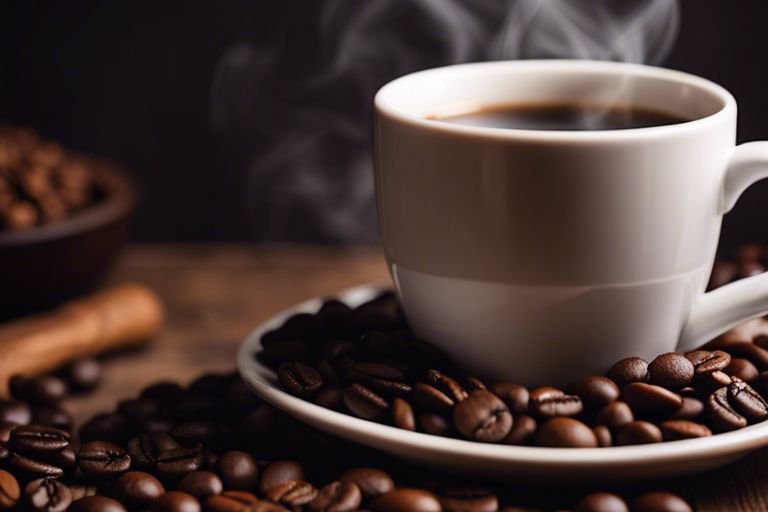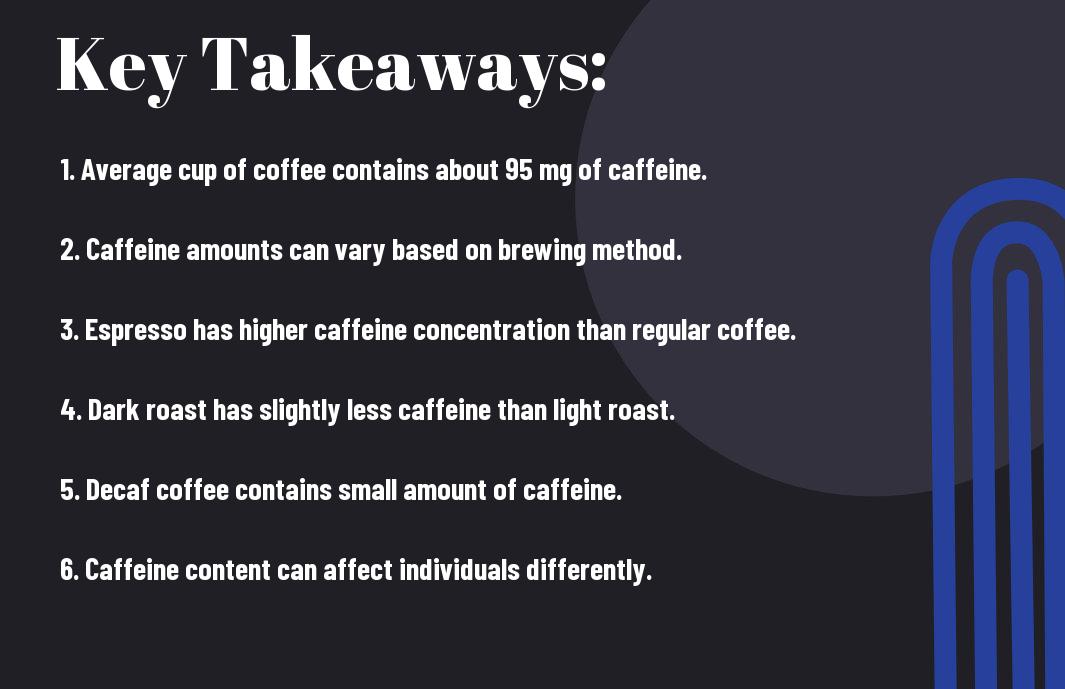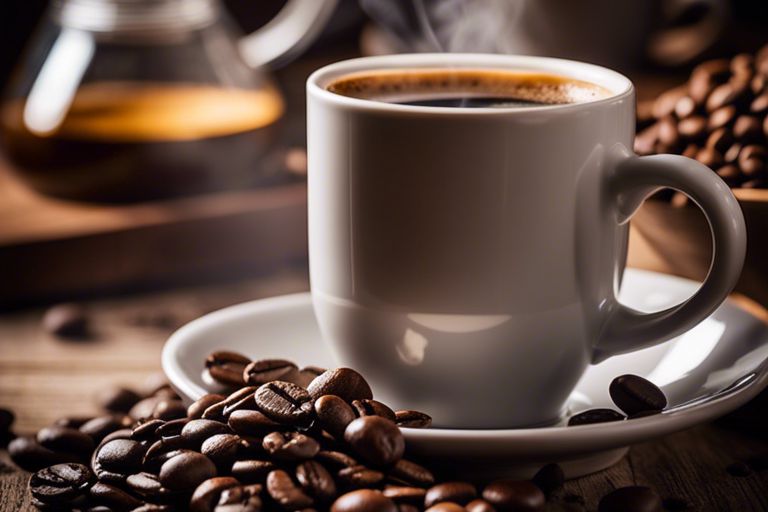With our daily dose of caffeine as crucial as ever, understanding just how much is in a cup of coffee is key. Join us as we research into the world of caffeine content in your favorite brew, breaking down the numbers and facts you need to know. Let’s uncover the caffeine mysteries lurking in your morning cup!

Key Takeaways:
- Range of caffeine levels: Caffeine content in a cup of coffee can vary greatly depending on factors like type of coffee beans, brewing method, and serving size.
- Standard amount: On average, a typical 8-ounce cup of coffee contains around 95 milligrams of caffeine.
- Espresso vs. brewed coffee: Espresso tends to have a higher concentration of caffeine per ounce compared to brewed coffee.
- Decaffeinated coffee: Despite its name, decaffeinated coffee still contains a small amount of caffeine, usually ranging from 2 to 5 milligrams per cup.
- Impact of caffeine: Caffeine affects individuals differently, so it’s vital to be aware of your own tolerance levels and adjust your coffee intake accordingly.

Caffeine Content in Coffee Beans
While coffee is a beloved beverage enjoyed worldwide, the caffeine content in a cup of coffee can vary depending on various factors.
Factors Affecting Caffeine Levels
- The type of coffee bean used
- The roast level of the bean
- The brewing method
- The coffee-to-water ratio
- The brewing time
Knowing these factors can help you better understand the caffeine content in your cup of coffee.
Average Caffeine Content in Different Coffee Bean Types
- Arabica Beans: 1.2% – 1.5% caffeine
- Robusta Beans: 2.2% – 2.7% caffeine
- Liberica Beans: 1.5% – 1.7% caffeine
- Excelsa Beans: 1.9% – 2.4% caffeine
- Typica Beans: 1.2% – 1.4% caffeine
Any coffee blend will have a caffeine content that falls within these ranges. Importantly, the type of bean used significantly impacts the caffeine levels in your coffee.
| Bean Type | Caffeine Content |
| Arabica | 1.2% – 1.5% |
| Robusta | 2.2% – 2.7% |
| Liberica | 1.5% – 1.7% |
| Excelsa | 1.9% – 2.4% |
| Typica | 1.2% – 1.4% |
The average caffeine content in a cup of coffee is largely influenced by the type of coffee bean used. Any coffee blend will have a caffeine content falling within the ranges mentioned above. Importantly, understanding these nuances can help coffee enthusiasts appreciate the differences in caffeine levels across various bean types.
Brewing Methods and Caffeine Extraction
There’s a lot to consider when it comes to caffeine extraction in coffee, and the brewing method you choose can have a significant impact on the caffeine content in your cup. According to Caffeine content for coffee, tea, soda and more, different brewing methods can result in varying levels of caffeine extraction, ultimately affecting how much caffeine ends up in your drink.
Drip Brewing: The Most Common Method
On average, drip brewing is the most common method used to prepare coffee. This method involves hot water passing through coffee grounds in a filter, resulting in a flavorful and aromatic drink. Drip brewing typically extracts a moderate amount of caffeine from the coffee grounds, making it a popular choice for everyday coffee drinkers.
French Press, Espresso, and Other Methods
Other brewing methods, such as French press and espresso, are known for extracting a higher concentration of caffeine from the coffee beans. French press coffee involves steeping the grounds in hot water and then pressing them to extract the flavor, resulting in a bold and strong brew. Espresso, on the other hand, is made by forcing hot water through finely-ground coffee beans under high pressure, producing a concentrated and robust shot of coffee.
Understanding the caffeine extraction process in different brewing methods can help you choose the right method based on your caffeine preferences. Whether you prefer a milder cup of coffee from drip brewing or a bolder espresso shot, knowing how caffeine is extracted can enhance your coffee brewing experience.

Caffeine in Coffee Drinks
Average Caffeine Content in Popular Coffee Drinks
All coffee drinks contain caffeine, but the amount can vary significantly depending on the type of beverage. On average, a standard 8-ounce cup of brewed coffee contains about 95 milligrams of caffeine. However, other popular coffee drinks such as espressos, lattes, and cappuccinos may contain different levels of caffeine due to variations in the brewing methods and ingredient proportions.
Variations in Caffeine Content Across Coffee Chains
With respect to ordering your favorite coffee drink at different coffee chains, it’s necessary to note that the caffeine content can vary. Factors such as the type of beans used, the serving size, and even the brewing technique can all influence the caffeine levels in your beverage. For example, a medium-sized coffee from one chain may have a different caffeine content than the same size from another chain, so it’s wise to inquire about the specific caffeine content if you’re watching your intake.
Coffee chains like Starbucks, Dunkin’, and local cafes each have their brewing methods and coffee bean blends, resulting in variations in caffeine levels. These differences can be subtle but may impact your overall caffeine consumption, especially if you’re a regular coffee drinker.
Factors Influencing Caffeine Intake
Despite the common belief that all cups of coffee contain the same amount of caffeine, there are several factors that can influence the actual caffeine content in your daily brew. These factors can range from the size of your cup to the ingredients you add to your coffee.
- Cup Size and Caffeine Content
Any avid coffee drinker knows that the size of your cup can significantly impact your caffeine intake. Larger cups typically hold more coffee, which means a higher caffeine content. A standard 8-ounce cup of coffee can contain anywhere from 80 to 100 milligrams of caffeine, but if you opt for a 16-ounce cup, that amount can easily double.
Adding Cream, Sugar, or Flavorings: Does it Matter?
Intake. If you’re someone who enjoys adding cream, sugar, or flavorings to your coffee, you may be altering the caffeine content without even realizing it. Factors such as the type and amount of cream or sugar you add can dilute the coffee and affect the overall caffeine concentration in your cup.
Recognizing how these factors can influence your caffeine intake can help you better understand how much caffeine you’re consuming and make informed choices when reaching for that next cup of coffee.
Health Effects of Caffeine Consumption
Recommended Daily Intake of Caffeine
To maintain a healthy balance, health experts recommend that adults consume no more than 400 milligrams of caffeine per day. This is roughly equivalent to four 8-ounce cups of brewed coffee. Consuming caffeine within this limit is generally considered safe for most people and can even have some health benefits.
Potential Health Risks and Interactions
An excessive intake of caffeine can lead to a range of potential health risks and interactions. It may cause symptoms like jitteriness, anxiety, insomnia, increased heart rate, and digestive issues in some individuals. Furthermore, consuming too much caffeine can lead to dependency, where the body becomes reliant on caffeine to function normally.
It’s important to be mindful of other sources of caffeine in your diet, such as tea, soft drinks, and chocolate. In some cases, combining caffeine with certain medications or supplements can also have negative interactions, so it’s advisable to consult with a healthcare provider if you have any concerns about your caffeine intake.
Coffee and Caffeine: A Cultural Perspective
After reading the detailed breakdown on How Much Caffeine Is in a Cup of Coffee, one can truly appreciate the cultural significance of coffee and its caffeine content. Coffee has been embraced worldwide, not just for its bold flavors but also for the invigorating caffeine kick it provides.
Coffee Culture and Caffeine Expectations
Any coffee aficionado knows that the ritual of brewing and enjoying a cup of coffee goes far beyond just the caffeine boost. It is a social activity, a pause in the day, and a way to connect with others. From the bustling coffee shops of New York City to the serene cafes of Paris, the love for coffee transcends borders and language barriers. Each culture has its own unique way of preparing and consuming coffee, reflecting its values and traditions. The expectations of caffeine content in a cup of coffee vary greatly, from a strong espresso shot in Italy to a creamy latte in Australia.
Regional Variations in Coffee and Caffeine Consumption
Caffeine plays a crucial role in shaping the coffee habits of different regions around the globe. In some countries, like Finland, where coffee consumption is among the highest in the world, the caffeine content in a cup of joe is a serious consideration. Similarly, in Japan, where precision and attention to detail are highly valued, the art of brewing coffee is taken to new heights, often resulting in a meticulously crafted beverage with just the right amount of caffeine to enhance the overall experience.
Caffeine expectations can also be influenced by local traditions and preferences. In parts of the Middle East, coffee is often brewed with spices like cardamom for added flavor, creating a unique blend of tastes that complement the caffeine kick. This interplay between cultural practices and caffeine consumption highlights the diverse and dynamic nature of coffee around the world.
Final Words
With this in mind, understanding the caffeine content in a cup of coffee is imperative for those who want to monitor their caffeine intake. By knowing the average amount of caffeine in different types of coffee, individuals can make informed decisions about their daily consumption to avoid any negative effects associated with excessive caffeine intake. It’s always recommended to be mindful of how much caffeine you’re consuming and to listen to your body’s response to it.
FAQ
Q: How much caffeine is typically in a cup of coffee?
A: The amount of caffeine in a cup of coffee can vary, but on average, an 8-ounce cup of coffee contains around 95 milligrams of caffeine.
Q: Does the type of coffee bean affect the caffeine content in a cup of coffee?
A: Yes, the type of coffee bean used can impact the caffeine content. Robusta beans generally have a higher caffeine content compared to Arabica beans.
Q: How does the brewing method affect the caffeine content in a cup of coffee?
A: The brewing method can influence the caffeine content. Generally, espresso tends to have a higher concentration of caffeine per ounce compared to drip coffee.
Q: Does the roast level of the coffee bean impact the caffeine content in a cup of coffee?
A: Contrary to popular belief, the roast level of the coffee bean does not significantly affect the caffeine content. The difference in caffeine between light and dark roasts is minimal.
Q: Can decaffeinated coffee still contain caffeine?
A: Yes, decaffeinated coffee still contains a small amount of caffeine. The decaffeination process removes the majority of caffeine, but there may still be trace amounts left in the beans.
Unlocking the Mystique – Exploring the Rich Flavor Profile of Black Coffee
The Ultimate Guide to Brewing the Perfect Cup of Black Coffee at Home
Health Benefits Unveiled – How Black Coffee Boosts Your Well-being





